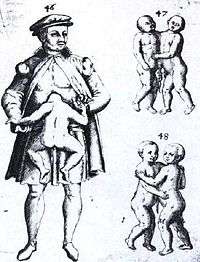Parasitic twin

Illustration of a man with a parasitic twin
A parasitic twin (also known as an asymmetrical or unequal conjoined twin) is the result of the processes that also produce vanishing twins and conjoined twins, and may represent a continuum between the two. Parasitic twins occur when a twin embryo begins developing in utero, but the pair does not fully separate, and one embryo maintains dominant development at the expense of the other. Unlike conjoined twins, one ceases development during gestation and is vestigial to a mostly fully formed, otherwise healthy individual twin. The undeveloped twin is defined as parasitic, rather than conjoined, because it is incompletely formed or wholly dependent on the body functions of the complete fetus. The independent twin is called the autosite.
Variants
- Conjoined parasitic twins joined at the head are described as craniopagus or cephalopagus, and occipitalis if joined in the occipital region or parietalis if joined in the parietal region.
- Craniopagus parasiticus is a general term for a parasitic head attached to the head of a more fully developed fetus or infant.[1]
- Fetus in fetu sometimes is interpreted as a special case of parasitic twin, but may be a distinct entity.
- The twin reversed arterial perfusion, or TRAP sequence, results in an acardiac twin, a parasitic twin that fails to develop a head, arms and a heart. The parasitic twin, little more than a torso with or without legs, receives its blood supply from the host twin by means of an umbilical cord-like structure, much like a fetus in fetu, except the acardiac twin is outside the host twin's body. The blood received by the parastitic twin has already been used by normal fetus, and as such is already de-oxygenated, leaving little developmental nutrients for the acardiac twin. Because it is pumping blood for both itself and its acardiac twin, this causes extreme stress on the normal fetus's heart. Many TRAP pregnancies result in heart failure for the healthy twin. This twinning condition usually occurs very early in pregnancy.[2] A rare variant of the acardiac fetus is the acardius acormus where the head is well-developed but the heart and the rest of the body are rudimentary. While it is thought that the classical TRAP/Acardius sequence is due to a retrograde flow from the umbilical arteries of the pump twin to the iliac arteries of the acardiac twin resulting in preferential caudal perfusion, acardius acormus is thought to be a result of an early embryopathy.[3]
Parasitic twins in fiction
- The X-Files TV episode "Humbug", features a former circus performer with a parasitic twin.
- Total Recall introduces a parasitic twin as the mastermind of an organisation.
- A character in God of War: Ascension was a parasitic twin.
- In Stephen King's 1990 novel The Dark Half and its 1993 film adaptation, the main character is the victim of his parasitic twin.
- The character Pinoko from Black Jack (manga) was originally a teratoma before Black Jack surgically extricates her from her twin, revives her, and gives her a synthetic body.
- The "Conjoined Fetus Lady" episode of the television series South Park featured a character named Nurse Gollum who has a dead fetus attached to her head. Kyle's mom explains parasitic twins and fetus in fetu, leading Stan to attempt to open his head with an ice pick to release a supposed parasitic twin.
- In A Canticle for Liebowitz a parasitic twin named Rachel begins to speak after nuclear war. Her coming to life poses certain theological questions for Abbot Zerchi of the monastery named after Saint Liebowitz. He attempts to baptize Rachel but she refuses as she seems to have been unaffected by Original Sin.
See also
References
- ↑ Aquino DB, Timmons C, Burns D, Lowichik A (1997). "Craniopagus parasiticus: a case illustrating its relationship to craniopagus conjoined twinning". Pediatric Pathology and Laboratory Medicine. 17 (6): 939–44. doi:10.1080/107710497174381. PMID 9353833.
- ↑ "Acardiac Twin or TRAP Sequence". University of California, San Francisco. 2007-04-26. Retrieved 2007-05-30.
- ↑ Abi Nader Khalil, Whitten Sara Melissa, Filippi Elisa, Scott Rose-Mary, Jauniaux Eric. Dichorionic triamniotic triplet pregnancy complicated by acardius acormus. Fetal Diagnosis and Therapy 2009;26(1):45-9.
External links
- Lebel, Robert Roger; Carlos Mock; Jeannette Israel; William Senica (June 1994). "Twin reversed arterial perfusion syndrome, acephalic presenting at full term". TheFetus.net. Retrieved 18 February 2013.
This article is issued from Wikipedia - version of the 11/10/2016. The text is available under the Creative Commons Attribution/Share Alike but additional terms may apply for the media files.